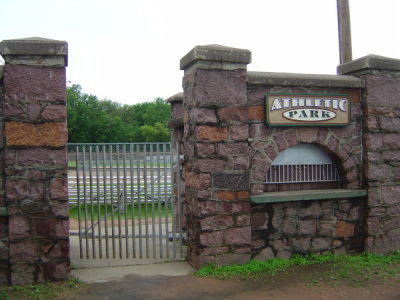This cache is NOT LOCATED AT THE ABOVE COORDINATES!
These coordinates will take you to the entrance of Athletic Park.
To find this final cache, you will need to visit the 4 other
caches in the Merrill City Park Series (all start with MCPS) and
obtain the clues to complete the following coordinates:
N45 11.ABC W089 42.0YZ

This local historic landmark, a 5-acre baseball field, began
hosting amateur and semi-pro baseball games in 1925. Completely
surrounded by an 8-foot granite wall constructed during the Great
Depression by the Works Progress Administration, Athletic Park is
one of the most scenic baseball fields in the State of Wisconsin.
Athletic Park has played host to such legends as Henry "Hank"
Aaron, Satchel Paige, and the Acme Packers. It is located on the
corner of Sixth Street and Logan Street, and it features a lighted
baseball field and restroom facilities.
Here is a great story about Merrill baseball days and Athletic
Park:
THE OLD BALL GAME
by Norm. W. Heideman (Merrill Centennial Record 1983, Quality
Print, Inc and Highland Publishers, July 1983)
Baseball over the years has been a favorite sport in and around
the city. It was circa 1910 when the game first gained popularity
in the area. There were always impromptu contests which sprang up
at picnics, family reunions and other social gatherings during the
summer. Diamond were laid out to suit the available playing area,
and in haphazard fashion.
Bats were a far cry from today's hitting implements. They were
homemade, cut, trimmed and shaped to the user's fancy. Some were
long, with a flat side and almost no taper at the handle at all.
Others were virtual fence posts, 40 to 50 inches long and weighing
up to ten pounds. The bottle bat derived its name because the bat
resembled an inverted milk or beer bottle. Such clubs gained
popularity in the late 20's and remained in use until the middle
30's, when they were outlawed. One slugger who used the bottle bat
to advantage was Charles "Buck" Moore, perhaps Merrill's most
prodigious clouter of home runs of all time.
Baseball here was very popular from around 1905 to World War I.
Some stalwarts of the diamond at the time were; Wm. Fries, Ray
Winner, Adlor Talbot, AI. Fries, Reno and Fred Schroeder, C.
Winneman, Emmett Hasset and Emil Semling. From available accounts,
Merrill always fielded a representative team, winning more games
than were lost.
Baseball uniforms of that era were in marked contrast to today's
apparel. They were predominately grey, although some were white
with pin stripes. The caps were not as roomy as today's. They were
flatter and had a tendency to fit snug on the players' heads. Old
photos show that at least a few players wore dress shoes on the
field. Pants were baggy and socks, with a complete foot completed
the uniform.
Local baseball attained some semblance of organization in the
20's. After the infamous "Black Sox Scandal" in 1920, several of
the banned players formed a touring team and played exhibition
tilts throughout the Midwest. When the club's business manager
absconded with the funds after a game against Merrill, a number of
the troupe was stranded. Some of the forsaken players sought work
here and joined the Merrill nine the following summer. Thus was
born Merrill's first paid team.
The city continued to field a professional team until the bottom
dropped out of the economy in 1929. Then came two decades of
amateur baseball. Moore took over as team manager.
Athletic Park has always been considered a first class baseball
facility. Fans from all over the state would marvel at how a small
community could boast such an impressive field. Soon after it was
designated as a baseball field in the late 20's, the diamond was
laid out, a grandstand built, and a wooden fence erected to enclose
the field.
Lights were installed at the park in the mid-30's. Night games
became the rule once the arcs were in place. The first game was
broadcast in 1949. Fans from throughout the area, unable to attend
games, would listen to these broadcasts.
Merrill fans enjoyed their paid teams of the 20's and start of
the 30's, but as the depression deepened, this luxury became a
victim of the time. It was after World War II that the policy of
paying some players was reintroduced.
After "Debs" Loud bowed out of baseball, the Merrill team was
taken over by Jim Schymanski, who had played in the Chicago White
Sox chain. Baseball was at its peak here, and Schymanski went out
to get the best players available. His success was attested to by
three straight state championships in 1951-52-53. Merrill played
about 50 games each season, most of them at home. In 1951 Merrill,
then known as the Rangers, traveled to Wichita, KS to represent
Wisconsin in the National Baseball Congress national
tournament.
Warren Weckwerth managed the team beginning in the late 50's
until the team disbanded after the 1961 campaign. Baseball in
neighboring cities also folded. The nearest thing to a city team at
present is the Merrill Giants' nine. Interest, however, has never
reached the zenith of the 20's and the 50's.